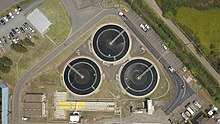Clarifier
[2] Concentrated impurities, discharged from the bottom of the tank, are known as sludge, while the particles that float to the surface of the liquid are called scum.
[7]: 5–9 Because of the large amount of reagent necessary to treat domestic wastewater, preliminary chemical coagulation and flocculation are generally not used, remaining suspended solids being reduced by following stages of the system.
[7]: 13 Methods used to treat suspended solids in mining wastewater include sedimentation and floc blanket clarification and filtration.
Considerable attention is focused on reducing water inlet and outlet velocities to minimize turbulence and promote effective settling throughout available tank volume.
[11] Tube or plate settlers are commonly used in rectangular clarifiers to increase the settling capacity by reducing the vertical distance a suspended particle must travel.
Tubes made of PVC plastic are a minor cost in clarifier design improvements and may lead to an increase of operating rate of 2 to 4 times.
This is done through routine inspections in order to ascertain the extent of sediment build up, as well as frequent cleaning of the quiescent zones, the inlet and outlet areas of the clarifier to remove any scouring, litter, weeds or debris that may have accumulated over time.
Reducing the velocity maximizes the hydraulic retention time inside the clarifier for sedimentation and helps to avoid excessive turbulence and mixing; thereby promoting the effective settling of the suspended particles.
[citation needed] The sludge formed from the settled particles at the bottom of each clarifier, if left for an extended period of time, may become gluey and viscous, causing difficulties in its removal.
This can cause the resuspension of particles by gases and the release of dissolved nutrients throughout the water fluid, reducing the effectiveness of the clarifier.
[citation needed] Improvements and modifications have been made to enhance clarifier performance depending on the characteristics of the substance undergoing the separation.




